Garden Room Bifold Doors: Homeowner’s Guide
Table of Contents

Garden Rooms and Bifold Doors: A Perfect Match
Why Bifold Doors Work Well in Garden Rooms
Garden room bifold doors offer a unique way to connect your indoor space with the outdoors. These doors, also known as concertina doors or folding doors, fold and stack neatly to one side, creating a wide opening that lets you fully embrace your garden views. On warm days, you can push them back completely, allowing fresh air to flow freely through your garden room.
The versatility of bifold doors makes them ideal for various garden room sizes. In smaller spaces, they maximize the available opening, making the room feel more spacious. Larger garden rooms benefit from the flexibility to partially or fully open the doors, depending on the weather and your preferences.
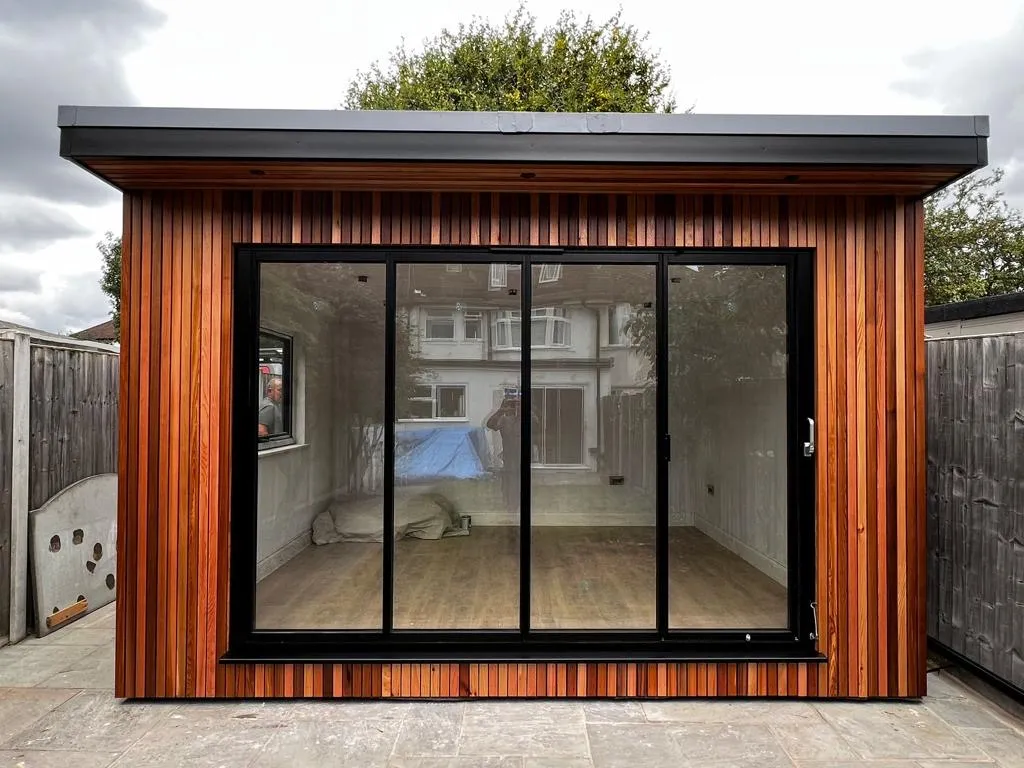
Framing Nature’s Beauty
Bifold doors for garden rooms act as a frame for your outdoor space. When closed, their large glass panels offer unobstructed views of your garden, bringing nature closer even when you’re indoors. This visual connection can make your garden room feel larger and more inviting, regardless of the season.
The ability to open up an entire wall of your garden room creates a smooth flow between indoor and outdoor areas. This feature is particularly useful for entertaining, allowing guests to move freely between spaces during gatherings or parties.
Choosing Doors for Garden Rooms
When selecting bifold doors for your garden room, think about how you’ll use the space throughout the year. Garden rooms with bifold doors can serve as home offices, art studios, or relaxation areas. Your choice of doors should align with the room’s primary function.
For year-round use, prioritise doors with excellent insulation properties. Look for models with low U-values, which indicate better heat retention. This feature is especially important if you plan to use your garden room during colder months.
Weather Resistance Matters
British weather can be unpredictable, so choose garden room bifold doors that can withstand various conditions. Opt for doors with robust weather seals to prevent drafts and water ingress. Aluminium frames often offer excellent durability and require minimal maintenance, making them a popular choice for garden room applications.
Consider the direction your garden room faces when selecting doors. South-facing rooms might benefit from doors with solar control glass to prevent overheating in summer. For north-facing spaces, highly insulating glass can help maintain a comfortable temperature year-round.
Sizing for Garden Spaces
Measuring Your Garden Room Opening
Accurate measurements are key when fitting garden room bifold doors. Start by measuring the width of the opening at three points: top, middle, and bottom. Use the smallest measurement to ensure your doors will fit. For height, measure both sides and the centre, again using the smallest figure.
Don’t forget to check for any obstructions like light switches or power sockets that might interfere with the door frame. It’s wise to leave a small gap (usually about 10mm) around the edges for fitting and any potential movement of the building.
Accounting for Threshold Options
When measuring for garden room with bifold doors, consider the threshold type you want. Low threshold or flush floor bifold doors provide an even surface between indoor and outdoor spaces, ideal for easy access. However, they might offer less protection against the elements. Higher thresholds provide better weatherproofing but can create a slight step.
Balancing Door Size with Garden Views
The number of panels you choose for your bifold doors for garden rooms will affect both functionality and aesthetics. Larger panels mean fewer frames obstructing your view, but they can be heavier and harder to manoeuvre. Smaller panels offer more flexibility in how you open the doors but introduce more frame lines.
Maximising Opening Potential
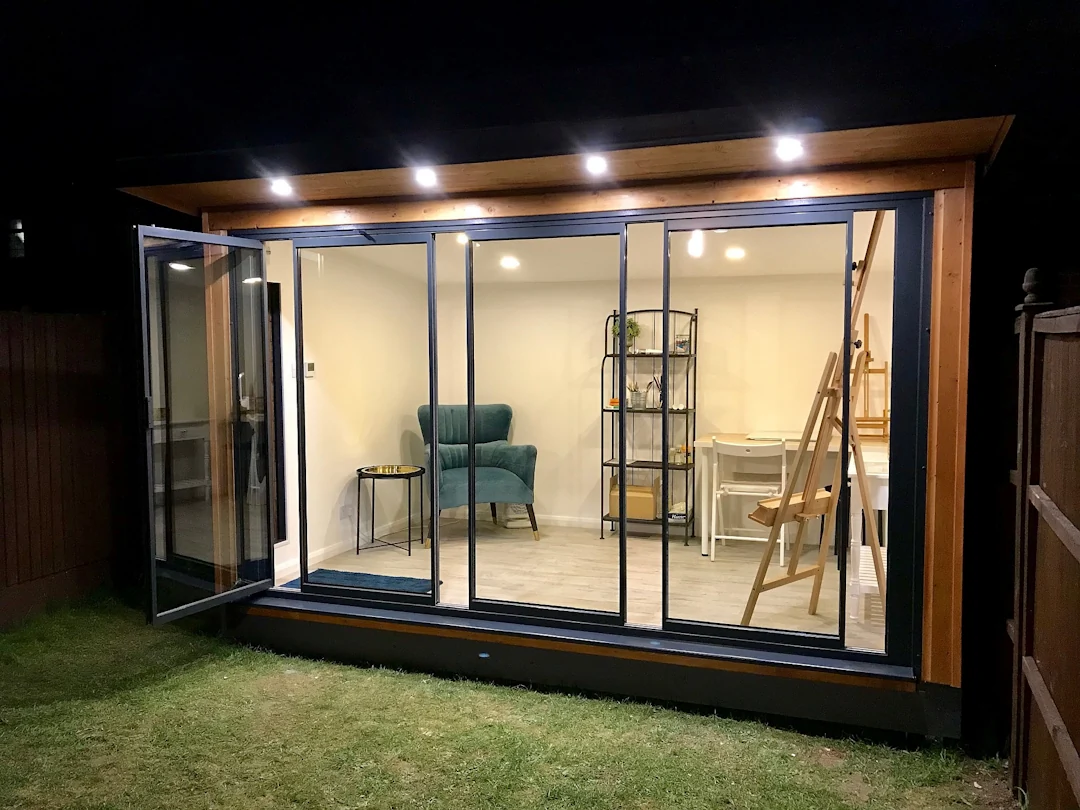
To make the most of your garden room bifold doors, think about how wide you want the opening to be when the doors are fully folded back. If you want to open up the entire wall, you’ll need to ensure there’s enough space for the stacked panels. This might influence where you position furniture or plants in your garden room.
Remember, the configuration of your doors can affect how they open. Some setups allow all panels to stack to one side, while others split the stack between both sides. Choose a configuration that works best for your garden room’s layout and how you plan to use the space.
Variations of traditional bi-fold doors include slide and swing doors (also known as slide and fold, slide and pivot, or slide and stack doors). These are often more space-saving than bi-fold doors whilst having all of their advantages.
Weather-Proofing Your Garden Retreat
Insulation for Year-Round Use
Garden room bifold doors play a key role in maintaining a comfortable temperature throughout the seasons. When choosing bi-fold doors, pay close attention to their U-value – a measure of heat loss. Lower U-values indicate better insulation. For garden rooms in the UK, aim for bifold doors with a U-value of 1.6 W/m²K or less.
Double glazing is standard for most bifold doors for garden rooms, but triple glazing offers superior insulation. While it comes at a higher cost, triple glazing can make a noticeable difference in heat retention during colder months. This extra insulation also helps reduce condensation, a common issue in garden spaces.
Frame Materials Matter
The frame material of your garden room bifold doors affects both insulation and durability. Aluminium frames are popular due to their strength and slim profiles, allowing for larger glass areas. However, they conduct heat more readily than other materials. Look for aluminium frames with a thermal break – a plastic insert that reduces heat transfer.
Timber frames offer excellent natural insulation but require more maintenance to withstand outdoor conditions. uPVC frames provide good insulation at a lower cost, but they may not be as durable as aluminium or timber in the long run.
Tackling British Weather Challenges
British weather can be unpredictable, so garden room doors need to stand up to various conditions. Rain is a particular concern, making water-tightness a top priority. Look for bifold doors with multi-point locking systems that create a tight seal when closed. Weatherstripping around the frame and between panels helps keep out drafts and moisture.
For garden rooms with bifold doors in coastal areas, consider doors with marine-grade finishes. These are designed to resist corrosion from salt air, ensuring your doors stay functional and attractive for longer.
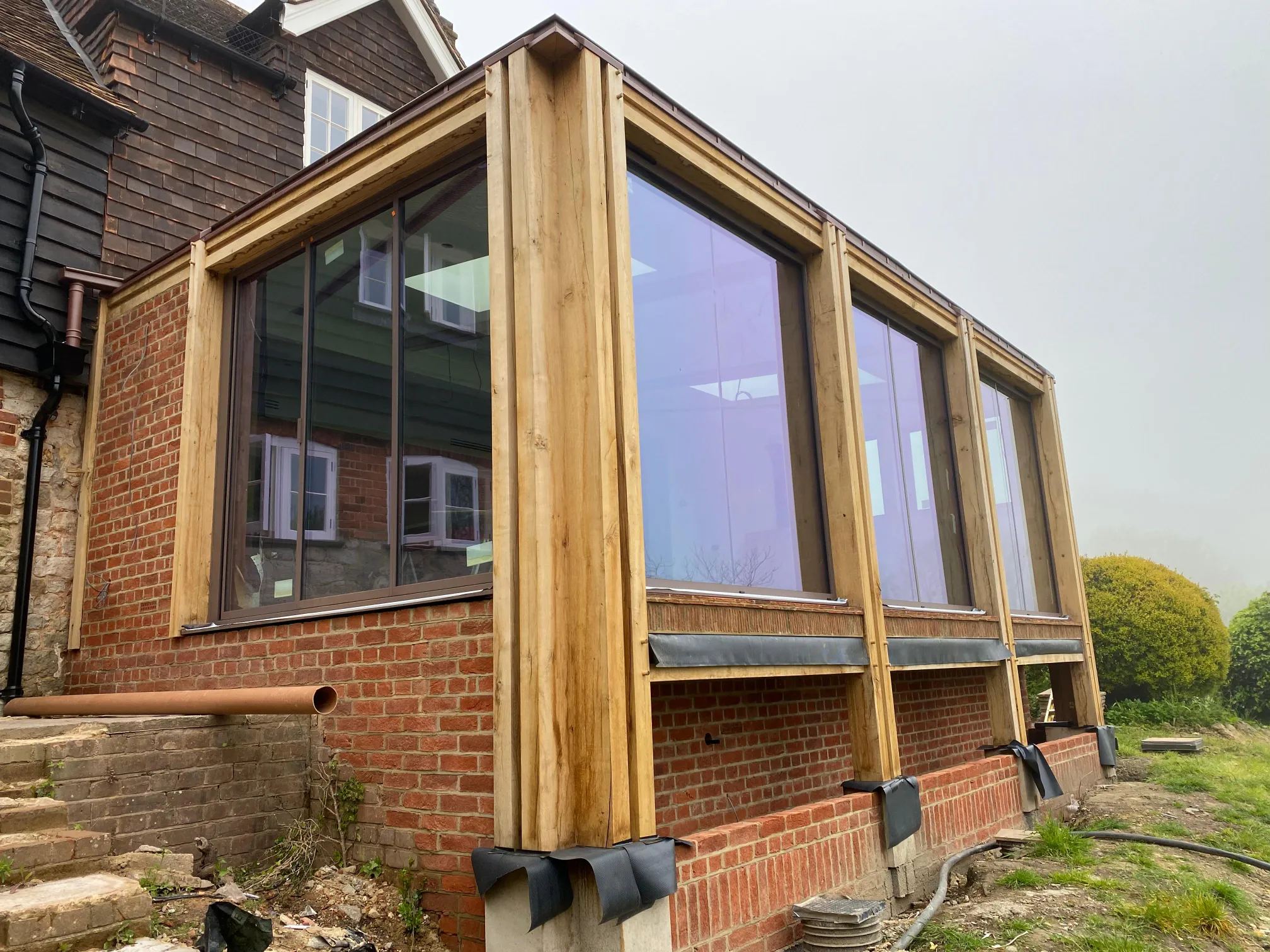
Dealing with Wind and Sun
Strong winds can put pressure on bifold doors, potentially causing them to bow or rattle. Choose doors with robust hinges and locking mechanisms to withstand wind pressure. Some manufacturers offer wind load calculations to ensure their doors are suitable for your specific location.
Sun exposure can lead to fading and warping over time. UV-resistant glass coatings can help protect your garden room’s interior from sun damage. For south-facing garden rooms, consider low-E glass, which reflects heat while still allowing plenty of light in.
Garden Room Bifold Doors Design Ideas
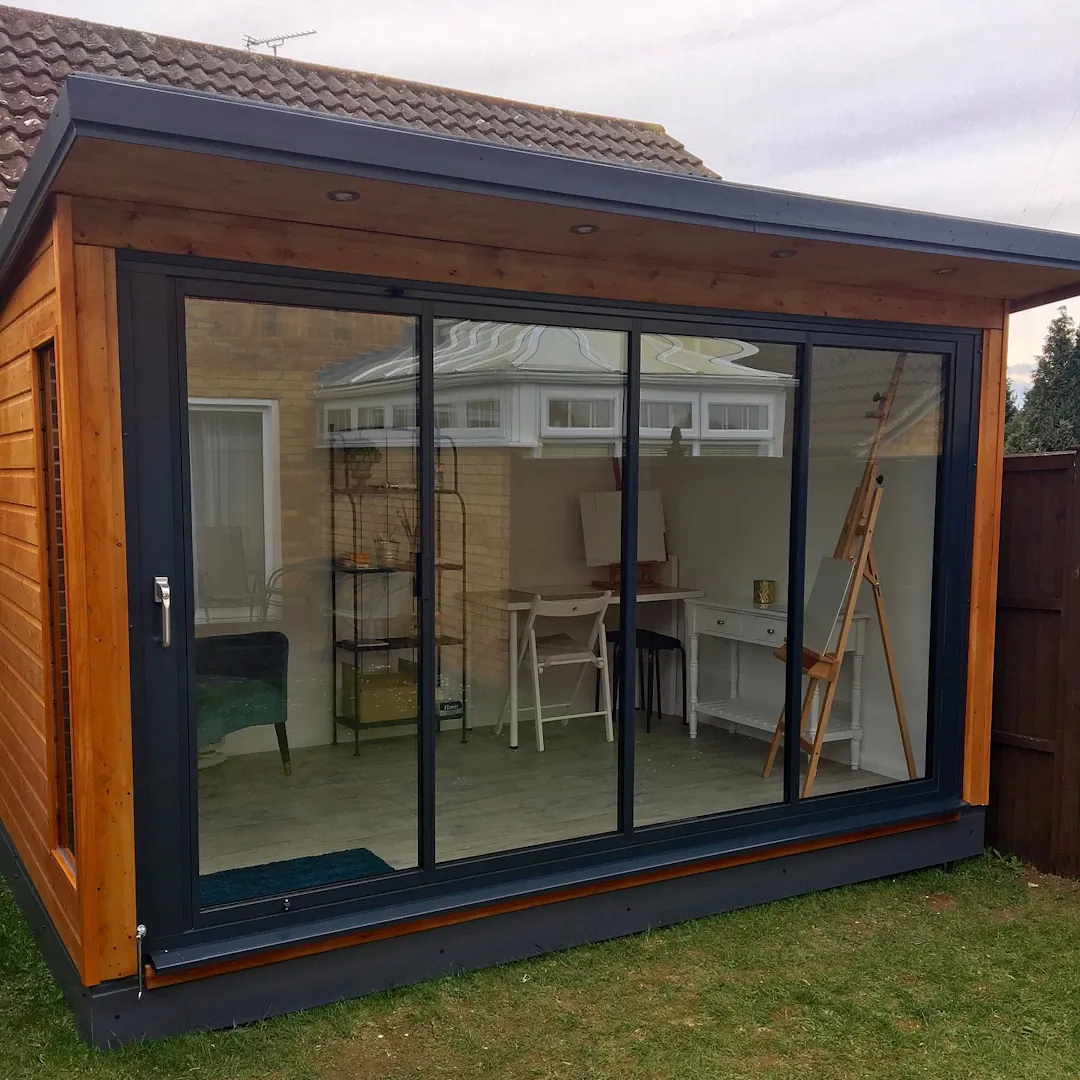
When fully opened, garden room bifold doors doors allow for unimpeded movement between your garden room and the outdoor area. This open-plan feel is particularly valuable during warmer months, effectively expanding your living space.
To maximise this effect, consider aligning your indoor flooring with your outdoor paving. Using similar materials or colours creates visual continuity, making the spaces feel more unified. For example, if you have wooden flooring in your garden room, you might opt for decking or wood-effect tiles in your adjacent outdoor area.
Furniture Placement
Thoughtful furniture arrangement can further improve the connection between your garden room with bifold doors and the outdoor space. Position seating to face the doors, allowing occupants to enjoy garden views even when the doors are closed. Consider using indoor-outdoor furniture that can be easily moved between spaces as needed.
Threshold Options for Easy Access
The threshold of your garden room bifold doors plays a key role in creating a smooth link to the outdoors. Low-threshold options minimise the step between indoor and outdoor spaces, making movement easier and safer. This feature is particularly beneficial for those with mobility issues or when you’re frequently carrying items between spaces.
However, it’s important to balance easy access with weather protection. While a completely flush threshold offers the smoothest passage, it may not provide adequate protection against driving rain. Many manufacturers offer rebated low-threshold options that strike a balance between accessibility and weather resistance.
Drainage
For doors for garden rooms that open onto a patio or decking, proper drainage is essential. Ensure the outdoor area slopes gently away from the threshold to prevent water from pooling near the doors. Some bifold door systems include built-in drainage channels to help manage water runoff.
In areas prone to heavy rainfall, consider installing a canopy or awning above your garden room bifold doors. This additional protection can help keep the threshold area dry, reducing the risk of water ingress and making the space more usable in wet weather.
Light and Privacy Balance
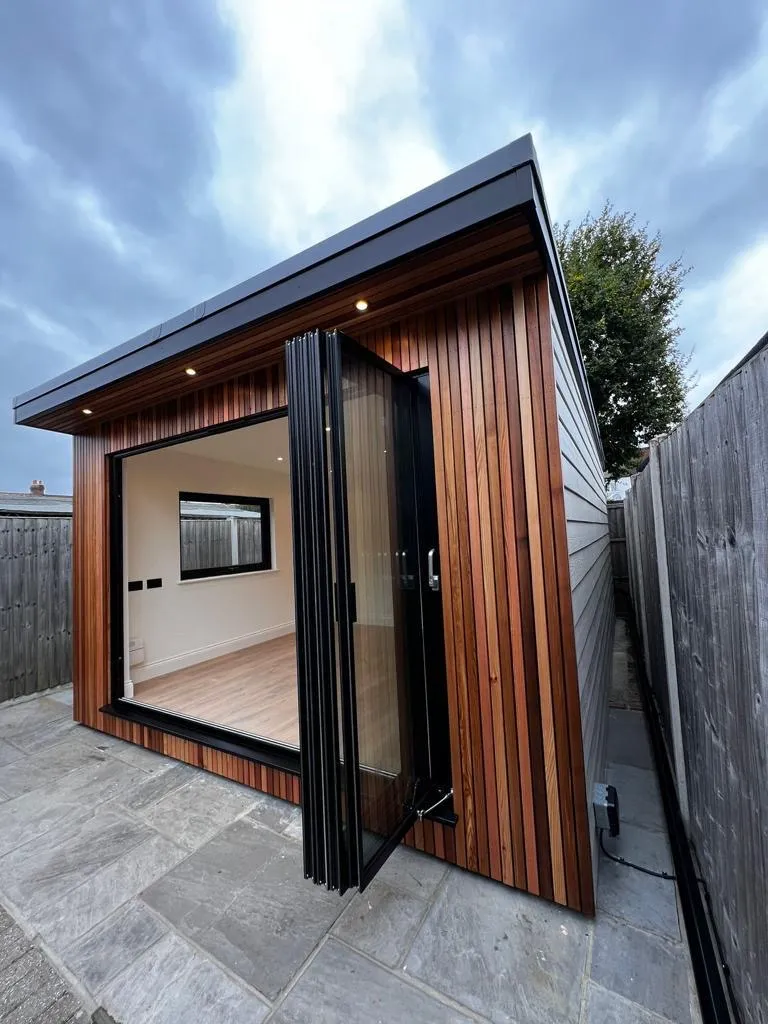
Making the Most of Natural Light in Your Garden Room
Garden room bifold doors offer an excellent way to flood your space with natural light. The large glass panels allow sunlight to penetrate deep into the room, creating a bright and airy atmosphere. This abundance of light can make your garden room feel larger and more inviting, even on overcast days.
When selecting bifold doors for garden rooms, pay attention to the frame-to-glass ratio. Opt for designs with slimmer frames to maximise the glass area. Some manufacturers offer ultra-slim frames that provide a nearly uninterrupted view of your garden, further blurring the line between indoor and outdoor spaces.
Glass Options for Light Control
While ample natural light is often desirable, too much can lead to overheating or glare. Consider low-emissivity (low-E) glass for your garden room bifold doors. This special coating reflects heat while still allowing light to pass through, helping to maintain a comfortable temperature without sacrificing brightness.
For south-facing garden rooms, solar control glass might be a wise choice. This type of glass reduces heat gain from the sun, keeping your space cooler during hot summer days without noticeably dimming the light.
Smart Shading Solutions
While garden room doors with bifold designs let in plenty of light, there may be times when you want to control it. Integrated blinds for bifold doors offer a neat solution, fitting between the panes of glass in your doors. These blinds can be raised, lowered, or tilted to adjust light levels and privacy as needed.
Balancing Views and Privacy
While the expansive glass of bifold doors for garden rooms offers stunning views, it can sometimes leave you feeling exposed. Strategically placed plants or decorative screens can provide privacy without completely blocking light or views.
Maintenance of Bifold Doors for Garden Rooms
Cleaning Bifold Doors
Keeping your garden room bifold doors clean is key to maintaining their appearance and functionality. The outdoor setting of a garden room exposes these doors to various elements, making regular cleaning essential. Start by removing loose dirt and debris with a soft brush or vacuum cleaner with a brush attachment.
For the glass panels, use a mild, non-abrasive glass cleaner and a lint-free cloth. Avoid cleaning the glass in direct sunlight, as this can lead to streaking. For stubborn marks, a solution of warm water and a small amount of washing-up liquid can be effective. Always rinse thoroughly with clean water to prevent residue build-up.
Frame and Track Care
The frames of your bifold doors for garden rooms require attention too. Wipe them down with a damp cloth and mild detergent solution. For aluminium frames, avoid using abrasive cleaners that could damage the finish. Wooden frames might need occasional treatment with appropriate wood oils or varnishes to protect them from the elements.
Pay special attention to the tracks of your garden room doors with bifold design. Keep them free from dirt, leaves, and other debris that could impede smooth operation. A small, stiff brush can be useful for dislodging stubborn dirt from the tracks. After cleaning, apply a silicone-based lubricant to keep the rollers moving freely.
Weatherproofing Checks and Maintenance
Regular checks of the weatherproofing elements of your garden room bifold doors can prevent issues down the line. Inspect the seals and gaskets around the doors for any signs of wear or damage. These components play a big role in keeping out drafts and moisture, so replace them promptly if you notice any deterioration.
Check the drainage holes in the threshold to ensure they’re clear of obstructions. These small openings allow water to escape, preventing it from pooling around the base of the doors. Use a thin wire or interdental brush to clear any blockages you find.
Seasonal Maintenance Tips
As the seasons change, so do the maintenance needs of your bifold doors for garden rooms. In autumn, be extra vigilant about clearing fallen leaves from around the doors and tracks. Winter might require more frequent cleaning to remove salt and grit that can accumulate if you use de-icing products nearby.
Spring is an ideal time for a thorough clean and check of your garden room bifold doors. Look for any damage that might have occurred over the winter months, such as cracks in the seals or issues with the locking mechanism. Addressing these promptly can prevent more serious problems from developing.
Lubricating Moving Parts
To keep your garden room bifold doors operating smoothly, regular lubrication of moving parts is essential. Focus on the hinges, locks, and rollers. Use a silicone-based lubricant or one recommended by the door manufacturer. Avoid oil-based products as these can attract dust and dirt, potentially causing issues over time.
Apply lubricant sparingly – a little goes a long way. After application, open and close the doors several times to distribute the lubricant evenly. Wipe away any excess to prevent it from attracting dirt or staining nearby surfaces.
Choosing the Right Style
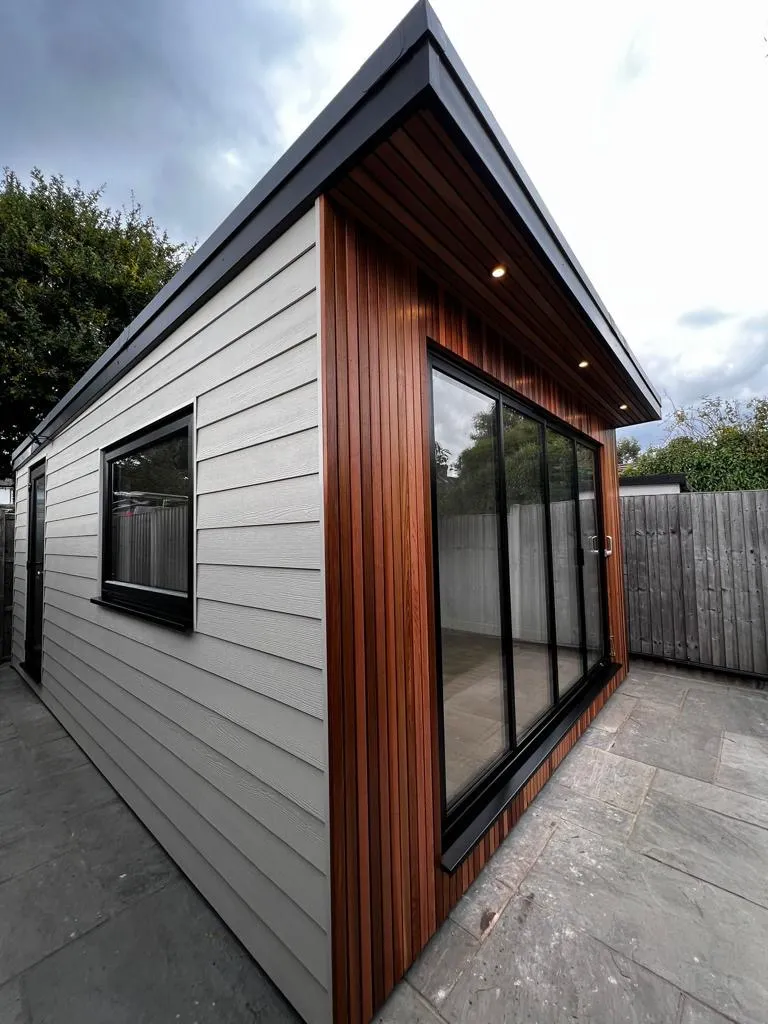
Complementing Your Garden Aesthetic
When selecting garden room bifold doors, it’s essential to choose a style that harmonises with both your garden room design and the overall look of your outdoor space. For a small garden room with bifold doors, opt for designs with slimmer frames to maximise the glass area, creating an illusion of more space. In contrast, a larger garden room extension with bifold doors might accommodate broader frames without compromising the open feel.
Consider the architectural style of your home and garden. Traditional properties often pair well with timber-framed bifold doors, which can be painted or stained to match existing woodwork. For contemporary homes, modern bifold doors with sleek aluminium frames can create a striking visual statement, complementing clean lines and minimalist designs.
Colour Choices and Finishes
The colour of your garden room bifold doors can really impact the overall appearance of the room. White frames are a popular choice, offering a clean, bright look that works well in most settings. However, don’t shy away from bolder options. Dark grey or black frames can create a striking contrast against light-coloured walls, adding a touch of sophistication to your garden room.
For those seeking a natural look, consider wood-effect finishes on aluminium frames. These offer the warmth and character of timber with the durability and low maintenance of aluminium. This option can be particularly effective in blending a modern garden room design with a more traditional garden setting.
Framing vs Frameless Options for Garden Views
The choice between framed and frameless garden room bifold doors can hugely affect your view and the overall feel of your space. Framed options provide a more defined structure and can be an integral part of your garden room’s design. They’re often more robust and can offer better insulation, making them a practical choice for year-round use.
Frameless or minimal frame designs, on the other hand, offer an almost uninterrupted view of your garden. These are ideal if you want to maximise the connection between your indoor and outdoor spaces. For a small garden room with bifold doors, frameless options can help create a sense of openness and continuity with the garden beyond.
Integrating Indoor and Outdoor Design Elements
To create a cohesive look, consider how your garden room bifold doors will interact with both interior and exterior design elements. Inside, think about how the doors will complement your flooring, furniture, and decor. Outside, consider how they’ll look alongside your landscaping, patio furniture, and any outdoor structures.
For a garden room extension with bifold doors, try to echo design elements from the main house to create a unified look. This might involve matching the door frame colour to existing window frames or choosing hardware that complements other fittings in your home.
Planning Permission and Building Regulations
When You Might Need Approval
Installing garden room bifold doors often doesn’t require planning permission, as they’re typically considered a permitted development. However, there are exceptions. If your garden room is close to a property boundary or if you live in a conservation area, listed building, or Area of Outstanding Natural Beauty, you might need to seek approval before making changes.
For a garden room extension with bifold doors, planning permission is more likely to be necessary. This is especially true if the extension increases the footprint of your property or significantly alters its appearance. It’s always wise to check with your local planning authority before starting any work, even if you believe your project falls under permitted development rights.
Navigating the Planning Process
If you do need to apply for planning permission for your garden room bifold doors, gather detailed plans and elevations showing the proposed changes. Include information about materials, dimensions, and how the doors will look in relation to your existing property and surroundings. Be prepared to explain how the doors will impact neighbouring properties, if at all.
Meeting Thermal Efficiency Standards
Building regulations apply to garden room bifold doors regardless of whether planning permission is required. These regulations ensure that any changes to your property meet certain standards, particularly in terms of energy efficiency and safety.
The U-value of your glass doors is a key consideration. This measure of thermal efficiency is particularly important for garden rooms, which are often used year-round. Current building regulations in the UK require a U-value of 1.6 W/m²K or lower for new or replacement doors. High-quality bifold doors often exceed this standard, offering excellent insulation for your garden room.
Safety and Security Regulations
Building regulations also cover safety aspects of garden room bifold doors. This includes the type of glass used – it must be toughened or laminated safety glass to reduce the risk of injury if broken. The doors must also meet certain standards for security, usually requiring multi-point locking systems.
If your garden room doubles as a guest bedroom, additional regulations may apply. These could include requirements for emergency egress, ventilation, and fire safety. Ensure your bifold doors provide a suitable means of escape in case of emergency.
Compliance for Different Uses
The specific building regulations that apply to your garden room bifold doors may vary depending on how you use the space. For example, if you’re using your garden room as a home office, you might need to meet different thermal and lighting standards compared to a space used purely for relaxation.
For a garden room extension with bifold doors that’s an integral part of your main living space, you’ll likely need to comply with the full range of building regulations that apply to home extensions. This includes rules about structure, fire safety, and access, in addition to the specific requirements for the doors themselves.
Need Doors for Your Garden Room?
Vision Glass Doors is a designer, manufacturer, and installer of premium door systems. We are a family run business with over 20 years’ experience and 5,000 installations across the UK.
All our systems are made to measure, designed, and fabricated at our manufacturing facility in Luton, Bedfordshire. We offer installation within a 100-mile radius.
Our leading range of door systems include Ultra Slim – Slide and Turn Doors, Slimline Sliding Patio Doors and Frameless Glass Doors. Suitable for various internal and external applications, they are applicable to residential and commercial projects.
Click Quick Quote Online for a free quotation within 24 hours. Alternatively, call or email us on 01582 492730 or at info@visionglassdoors.co.uk.

